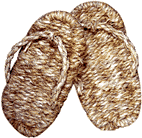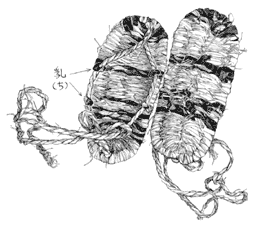|

Japanese straw sandals, called waraji, have been worn by lower class Japanese since ancient times. During the Sengoku era, this type of footwear was adopted by all ranks of Bushi. Because of their diposable nature, journeys were measured in how many pairs of waraji were worn out. This diagram illustrates the making of one type of warji. These waraji have hanao (thong part of the sandal) made of rice straw like the rest of the sandal, but this style waraji can also be worn with padded cloth hanao.

Here is a finished pair of the waraji illustrated in the above diagram. These waraji appear to be pre-cursors to zori, which I have not found any period documentaion for. Zori apperars to be a post-meiji development. Topped with a straw mat, zori are somewhere between geta and waraji.

This is the style more commonly seen in period sources, and probably the most practical if you're going to be walking around much, since they are strapped securely on to your foot.
|

